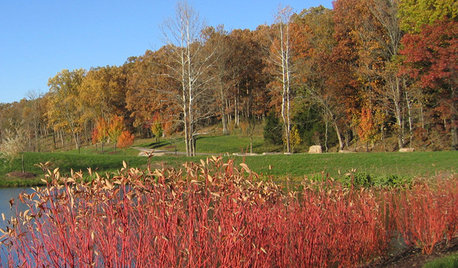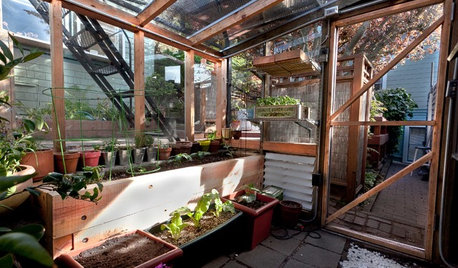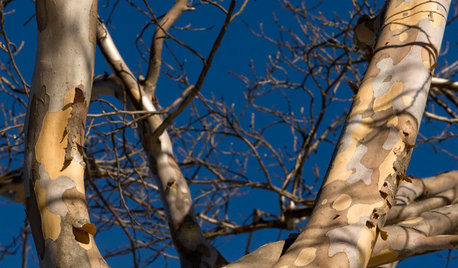Providing winter shelter
Chris Reher, z5b
4 years ago
Featured Answer
Sort by:Oldest
Comments (6)
gardengal48 (PNW Z8/9)
4 years agolast modified: 4 years agowhaas_5a
4 years agoRelated Discussions
Any trees that provide food for birds in late winter?
Comments (20)I have thickets of wild crabs out in the back of my lot, and they make an assortment of sizes and colors of berries. Some of them get eaten during the fall. Others linger for months. The ones that don't get eaten right away tend to be the big fat crabapples - perhaps the bigger ones need to be go through bletting - where the fruit softens and shrivels over the winter (hopefully I'm describing that right). 2010 was a poor year for fruiting on the Crabapples - as well as many of the birds sources of food - probably the drought. Some of the bigger fruits were being eaten during the fall. Anyway, took this pic last February 17th - 2009 was a great year for the Crabs, and there were still lots of fruits on this tree -...See Morewhat should I cut back? (pics)
Comments (14)You might want to remove the spent blooms on the buddleia and agastache's to prevent heavy reseeding. I keep my buddleia's deadheaded throughout the season, and always whack my 7'er back to about 4' now, then as far back as I can in the spring. It's over 10 years old and has a huge trunk, so it can't be pruned back lower than 2' anyway. I've pruned it both in winter & in spring, and it always comes back. If you're a bird person, the goldfinches would probably love you for leaving the heads on the agastaches, but come spring time, you'll probably have loads of seedlings (all in the wrong place, like me!). As for the daylilies, I don't think it matters when you whack them back, but like most bulbs, you shouldn't cut them back if they're still green. Considering it's hard to kill a daylily (IMO), you should be okay. Same with hostas; I can't kill mine. I tend to leave my few ornamental grasses up; I like to see them poking up through the snow. Azaleas should be pruned right after they bloom; never much later (see rhizo's reply)....See MoreFicus Carriea in Pennsylvaina?
Comments (4)Bearing fruit is a different aspect of the plant than survival in the winter. Unless you have to have it in the ground which will require tremendous efforts to keep the plant alive, you can grow any variety for fruiting in pots but you have to provide winter shelter and then summer warmth (rather heat). Search this site for winter protection techniques. I am in Zone 5a (and sometimes colder) but I bring my plants inside to a cold storage (temp 44F~49F) after start of dormancy. Then I take it out to a sunny warm location. To help the fruit ripen you have to provide a warm (hot better) spot. Placing close to south facing wall will help a lot. You may keep on looking for a cold hardy fig variety for Zone 5A and let us know the good news when you experience one. But you can grow and ripen fig in pots with proper care. Winter them in garage or cold storage. Bring them out to sun and heat when the danger of frost is gone....See MoreLow tunnels or other shelter for winter veggies
Comments (1)I've had good luck with tunnels made from EMT pipe covered with greenhouse-grade plastic (UV resistant) and held together with clips that look sort of like hair rollers - they're available from Charley's Gre-nhouse (sorry, trying to avoid those dump underlined links some of us are getting when certain key words are used) and probably other sources that sell gre-nhouse supplies. I use a pipe bender to shape the half-inch-diameter EMT pipe into a shape that looks like a child's drawing of a house with a peaked roof - straight angles instead of curves, as the clips hold on better that way. And if you can orient the tunnels with a short end toward your prevailing wind, you'll probably have better luck. Is it foolproof? No. I did 8 tunnels last year, each six feet long, and one had some rips in it from...well, I'm not sure what, and another lost all the plastic in a winter storm. Doing several smaller tunnels gave me some insurance, though, and we harvested goodies from those tunnels for a long time. Good luck with yours! katie...See MorePat Z5or6 SEMich
4 years agoChris Reher, z5b
4 years agoEmbothrium
4 years ago
Related Stories

GARDENING GUIDESThese Hedges Can Add Interest to Your Winter Garden
Evergreen trees and shrubs provide structure and color in the winter months — and can attract wildlife too
Full Story
DECLUTTERINGShed Winter Clutter to Lighten Up Your Home for Warmer Days
Take a fresh approach to spring cleaning with these 6 ways to declutter cold-weather items
Full Story
FLOWERS AND PLANTSRhus Hirta Provides Brilliant Foliage Color in Autumn
Plant staghorn sumac for its wildlife value, beautiful fall color and bright red fruit that persists into winter
Full Story
ARCHITECTUREShade in Summer, Sun in Winter
Louvered sunshades filter light when it's hot, let it in when it's not
Full Story
FLOWERS AND PLANTSTry This Unthirsty Evergreen for Fall and Winter Interest
Juniperus virginiana, with berrylike seed cones, adds an exclamation point to eastern North American gardens
Full Story
SMALL HOMESHouzz Tour: A Student's Bed-Size Shelter in the Arizona Desert
Could you sleep in such a small space just above the desert floor? One Taliesin architecture student at a time does just that
Full Story
WINTER GARDENINGWarm Up a Greenhouse for Winter
Add heat and light to keep plants growing through the winter
Full Story
REMODELING GUIDESExtend the Roof for Shade and Shelter
Block the sun and rain with a modern brow-like extension of your roof
Full Story
HOLIDAYSVintage Sleds Bring a Dash of Winter Nostalgia
Antique sleds add a rustic touch to holiday decor — and can evoke fond memories too
Full Story
WINTER GARDENING8 Gorgeous Trees for Winter Interest in the Garden
Intriguing forms and beautiful branches take center stage when color heads back into the wings of the winter landscape
Full Story




popmama (Colorado, USDA z5)